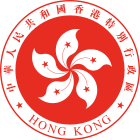Development_Bureau
The Development Bureau (DEVB; Chinese: 發展局) is an agency of the Government of Hong Kong responsible for urban planning and renewal, land administration, infrastructure development, building safety, landscape, greening & tree development, water supplies, flood prevention and heritage conservation.[1]
| 發展局 | |
 Emblem of the Hong Kong SAR | |
| Agency overview | |
|---|---|
| Formed | 2007 |
| Headquarters | 18/F, West Wing, Central Government Offices, 2 Tim Mei Avenue, Tamar, Hong Kong |
| Ministers responsible |
|
| Agency executives |
|
| Website | www.devb.gov.hk/ |
| Development Bureau | |||||||||||||
|---|---|---|---|---|---|---|---|---|---|---|---|---|---|
| Traditional Chinese | 發展局 | ||||||||||||
| Simplified Chinese | 发展局 | ||||||||||||
| |||||||||||||
The Bureau is supervised by the Secretary for Development.[1][2][3]
The Development Bureau of Hong Kong was created on 1 July 2007 as part of a governmental reorganisation introduced under Donald Tsang.
Responsibility for urban planning, environmental protection, and lands administration originally fell under the Planning, Environment and Lands Bureau when the Hong Kong SAR government was established in 1997.
Beginning 1 January 2000, the responsibility for environmental protection was transferred to the Environment and Food Bureau; the Planning, Environment and Lands Bureau was renamed Planning and Lands Bureau.
When the Principal Officials Accountability System went into effect on 1 July 2002, the Housing Bureau and Planning and Lands Bureau were combined into the Housing, Planning and Lands Bureau.
In 2007, the Development Bureau was established and took over the responsibility of planning and lands administration from the Housing, Planning and Lands Bureau, public works from the Environment, Transportation and Works Bureau, and heritage conservation from Home Affairs Bureau.
In July 2023, it was revealed that the Development Bureau was considering direct land grants, rather than open tenders, for the San Tin Technopole.[4]
The Bureau comprises six divisions under two branches overseen by respective Permanent Secretaries:[5]
Planning and Lands Branch
The Planning and Lands Branch oversees the urban planning and redevelopment in Hong Kong. Its responsibilities include ensuring a sufficient land supply and optimising land use, implementing urban renewal plans and maintaining a land administration system. The divisions under the Planning and Lands Branch are:
- Lands Division
- Planning Division
- Urban Renewal and Buildings Division
Works Branch
The Works Branch of the Bureau focuses on the management and implementation of infrastructure, as well as heritage conservation and maintenance in Hong Kong. The divisions under the Works Branch are:
- Heritage, Programme and Resource Division
- Works Policies and Infrastructure Projects Divisions
- Legal Advisory Division (Works)
- Energizing Kowloon East Office (EKEO)
The following public agencies are managed by the bureau:[6]
The plans to redevelop Kowloon East, an industrial area that spans along the Victoria Harbour between Kwun Tong, Kowloon Bay and former Kai Tak Airport, was first announced in a policy address on 12 October 2011.[7] The redevelopment plan would transform Kowloon East into a second central business district in addition to Central. In June 2012, the Development Bureau founded the Energising Kowloon East Office as an entity under the Works Branch to steer and oversee the development of this area.
- "Development Bureau - Home". Archived from the original on 25 January 2010. Retrieved 6 April 2010.
- "Community project for seniors creates jobs". Archived from the original on 31 March 2010. Retrieved 6 April 2010.
- Cheng, Mandy (15 July 2023). "Explainer: What is Hong Kong's San Tin Technopole and why is the planned tech hub controversial?". Hong Kong Free Press HKFP. Retrieved 18 July 2023.
- "Organisation (21)". DEVB. Retrieved 17 May 2018.
- "Energizing Kowloon East - About Ekeo - Organization". www.ekeo.gov.hk. Archived from the original on 26 March 2015. Retrieved 9 April 2014.